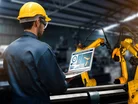Applying automation to manufacturing supply chains

It is very tempting to stick with strategies that work in supply chains. However, changing your approach toward supply chain objectives is crucial as time progresses. That's because a well-performing supply chain is necessary for every business owner. However, the efficiency of the supply chain depends on several internal and external factors. The internal factors can include elements like:
- Product introductions
- Distribution network expansion
- Supply cut-offs, etc.
Several external factors can also impact the performance of the supply chain, including:
- Weather
- Extreme seasonality
- Changes in customer perception
- Media coverage
It can be challenging for manufacturers to handle many different aspects of the supply chain. Fortunately, incorporating automation and intelligence as a manufacturer is the smartest way to deal with them.
Artificial Intelligence (AI) is considered the top option to optimise the supply chain, as experts consider it an extension of our brains. It expands our cognitive abilities to levels we previously thought impossible. Many people believe AI can’t replace us, but it can help us optimise various business-related processes, including supply chain management.
Back-office
Supply chain management with AI makes administrative tasks straightforward through certain tools, such as an inventory manager or auto-replenishment software. These tools can allow business owners to pull all order detail information into the software automatically. Similarly, automatic invoice processing is another smart approach to make financing and accounting easier.
This way, manufacturers can keep track of the customer, sales, ROI, and other financial aspects without spending hours on data reconciliation. It can also help with inventory planning, forecast, supply chain and procurement. Moreover, cognitive analytics automation can also play a part in optimising the overall supply chain process.
Transportation
Automating route optimisation allows business owners to assign the most effective routes for transport. Carriers can cut their transportation costs and time with the most optimal route. For example, you can use some of the following steps for route optimisation:
- Check the current vessel traffic online
- Find the shortest route distance to the destination
- Make the least maintenance stops on the way.
Moreover, shipment visibility via real-time updates for shippers, receivers, etc., makes the process easier. You can also use this info to track the movement of your goods and update the clients if required.
Automation and intelligence in warehouse operations
The use of automation and intelligence is most versatile between the warehouse department and supply chain operations. They can automatically send and receive orders for replenishment, saving you from manual management.
In more advanced intelligence and automation cases, you can direct the replenishment to the closest fulfilment centre. Regarding picking orders, the automation tools — combined with automated transportation — can provide seamless inventory updates.
You can use these tools to improve the workers' speed in picking warehouse stock and replacing it when required. Modern automation tools provide more sophisticated options to business owners: they can help recommend the ideal package size to minimise the dimensions and packaging requirements.
Some automated inventory management tools can also help business owners identify the best places to store their goods. For example, if there's a light-sensitive inventory item, the automated system can store it in a darker area.
Inventory management in manufacturing
Inventory management is one of the most complicated aspects of supply chain management. However, you can automate it fully using the right tools, and make it suitable for your business needs. Most professionals in the supply chain industry use automated record points and replenishment tools to provide the best inventory levels visibility and restock as required.
While applying automation and intelligence to navigate the supply chain as a smart manufacturer is easy, there are some potential challenges to keep in mind. These challenges include:
System complexities
AI systems are cloud-based and require an internet connection — challenging in some facilities
Scalability
Finding the right methods for your scalability is the most crucial aspect.
Training Costs
Automation in the supply chain also requires training, especially if the workers have no experience with AI.
Operation costs
These systems are costly: They require systems for calculating ideal freight rates and include systems and parts that need time-to-time updates.
The bottom line in manufacturing
Applying automation and intelligence for supply chain navigation can greatly benefit you as a manufacturer. You can use these tools in your inventory, transportation, warehouse, and other business areas.
Make sure you address the biggest challenges first; you shouldn't have a problem streamlining your automated warehouse. Start by creating an automation plan, and the rest of the steps will fall in line.
Jake Rheude is the Vice President of Marketing for Red Stag Fulfillment, an eCommerce fulfillment warehouse that was born out of eCommerce.
- Schneider Electric: Powering Manufacturing Via Cloud DataDigital Factory
- LG Electronics Enters Smart Factory Market with AI TechSmart Manufacturing
- Key Themes at Manufacturing & Mobility LIVE 2024Production & Operations
- Dassault Systèmes & Mistral AI Advance Generative EconomyAI & Automation
